Review
| Groundstrokes | 81 |
|---|---|
| Volleys | 81 |
| Serves | 81 |
| Returns | 79 |
| Power | 79 |
| Control | 84 |
| Maneuverability | 84 |
| Stability | 80 |
| Comfort | 89 |
| Touch/Feel | 82 |
| Topspin | 84 |
| Slice | 80 |
Fresh for 2019, the ProKennex Ki Q+ Tour Pro (315) offers players best-in-class comfort, a thin box beam and a low stiffness rating. These features provide a classic feel for modern players. Our playtesters were happy to get an arm-friendly racquet in their hands and take a nice break from some of the stiffer frames they have been testing. They found a solid amount of control, along with enough maneuverability to ramp up the power and put balls away. The open string pattern offered good access to spin and nice pocketing, which allowed our testers to redirect pace and hit their targets. Our team loved the easy access to precision, power and control on serves, as well as the plentiful touch on volleys. With its race-ready cosmetics, this Ki Q+ Tour Pro (315) proved to be a solid option for serious players craving a comfortable racquet that packs a punch.
Upsides
- Comfort
- Spin
- Control
Downsides
- Nothing we could agree on
Bottom Line
Blending a traditional box beam construction with a lively response, this racquet strikes an appealing balance of comfort, power and control.
Ability
Advanced
Groundstrokes - Score: 81
The specs of the Ki Q+ Tour Pro (315) seemed to fit right into all four of our playtesters' games. Chris quickly found his groove with this racquet from the baseline. He said, "The weight and balance felt right for my style of play. I found it easy to maneuver this racquet, and I could accelerate it to inject some added spin or pace when I wanted. I also liked my ability to flick the racquet through contact when stretched wide. There was enough pop for me to find depth easily. In the past, I've found Kinetic racquets to feel lively with the sense that the moveable mass adds some depth to shots. I definitely got that sense with this racquet; the ball seemed to jump off the stringbed compared to other racquets with a similar beam design and specs, such as the Dunlop Srixon CX 200 Tour 16x19 and the Tecnifibre TFight 315 XTC Ltd. The Kinetic system also provided a very comfortable dampened feel. The response is a little different, but it didn't take me long to get used to the feel of this racquet."
"The control and easy access to spin put the Ki Q+ Tour Pro (315) right in my wheelhouse, especially from the baseline," said Troy. "The head size, string pattern and flex are almost identical to my racquet of choice, the Yonex VCORE Pro 97 (330). The only noticeable spec difference is this racquet is 30 grams lighter; it also yields a lower swingweight by roughly 10 points. It had a fast and maneuverable feel to it, which allowed me to whip it around really easily on my forehand. When hitting forehands on the run, I could easily snap my wrist to create sharp angles and even hit a few banana shots down the line. When I hit the Ki Q+ Tour Pro (315) side by side with the Dunlop Srixon CX 200+ I noticed a huge increase in maneuverability with this racquet. The comfort was great, as expected from a ProKennex racquet. Slice shots felt nice and smooth, and I got a lot of backspin on the ball and kept it low. The stability was surprisingly good even with it being lighter than my preferred spec. That said, I would bump up the swingweight with some customization to gain a little more plow through. I felt very confident picking my spots when hitting groundstrokes, and I felt like I could dictate points by keeping my opponents on the run."
A standard length box-beam frame with a 98-square-inch head size, open string pattern, and 11.7-ounce strung weight is a formula that usually produces good results for Mark. He described, "This racquet proved to be very effective on groundstrokes for my game. I was comfortable from the backcourt within five minutes of play. After an hour of play I was right at home with it, and I could hit close to the lines with decent pace and spin. My only knock from the baseline was that my backhand slice did not feel as natural as I would have hoped, and I think it had something to do with the grip shape."
Michelle was captivated by the Ki Q+ Tour Pro (315)'s balance of features. She said, "This racquet had a great blend of power and control. I know we end up saying that about a lot of racquets, but I found the power levels here to be relatively low, so I never was worried about overhitting. I was also successful stepping up and swinging fast. I don't always love the more 'classic' feeling racquets and tend to prefer a more modern, stiff frame, but this Tour Pro (315) felt solid off the ground. After playtesting a bunch of firm racquets, the Kinetic technology was a nice break for my tendons! I was happy to find I could step up and put balls away with this racquet as well. It felt relatively consistent in my hands off the ground. No complaints from me — it's a solid racquet!"
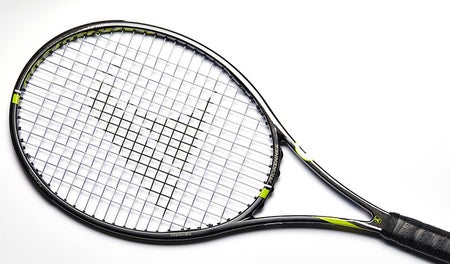
Volleys - Score: 81
Quick to get into position, the Ki Q+ Tour Pro (315) lent our team great feel at net. Troy enjoyed the easy maneuverability and precision this racquet provided on his volleys. He explained, "My targeting was precise, and I felt like I could utilize all the angles of the court. When playing doubles, I could easily manipulate this racquet during quick volley exchanges. The stability was pretty good too. It wasn't quite as solid as the Wilson Pro Staff RF97 Autograph, but it didn't flutter in my hand. The feel on contact was a bit muted with the Kinetic technology, but it felt very comfortable on my wrist. My only knock was that I would have liked a little more punch or power to help gain easier depth. There were times when I had to block the ball back, and my volleys seemed to land a bit short."
The combination of specs definitely complemented Mark's volleys. He said, "The aspect that stood out to me the most was the feel at contact with the ball. Perhaps I might have been sensing the Kinetic technology, but I am inclined to say that it had more to do with the fact that this is a 'ye olde' traditional box-beam racquet with great feel."
Michelle felt like she had a solid command of the ball up at net. She said, "This racquet had a lot of feel and allowed me to place volleys exactly where I wanted. It was maneuverable and fairly stable at net. Again, the softer feel was nice for a change, and I never felt any harsh shock swinging away at bigger balls."
For Chris, the racquet felt light and easy to maneuver at net. He noted, "I was able to punch volleys deep with solid pace. I was impressed by how stable the racquet remained during hard hitting, considering how light and fast it felt to maneuver. It didn't take me long to get used to the feel of the racquet, and I was finding my targets on drop volleys and placement volleys."
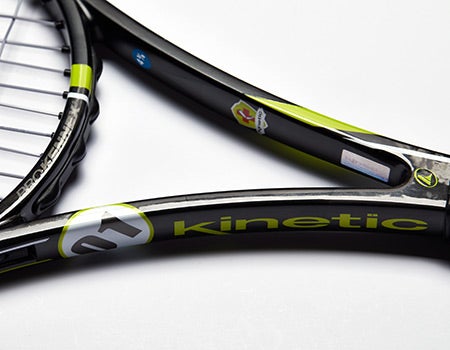
Serves - Score: 81
All of our playtesters found ample access to spin and hit their targets successfully when serving with the Ki Q+ Tour Pro (315). Mark had no problems with his serve. He said, "Velocity-wise, I did not climb past 103 MPH, but most of my serves felt effortless, effective and most importantly, consistent."
Michelle also had an easy time serving with this racquet. She added, "In all honesty, I did not think I would be able to hit big first serves, but I was pleasantly surprised that I could execute decent pace. Slice and kick serves were seamless to hit. I wouldn't say I was hitting the best serves of my life, but I did feel confident starting the point offensively with this racquet."
There was impressive power and spin on tap for Chris. He said, "I found the response to be lively enough that I never felt like I had to work hard to serve with pace. The Ki Q+ Tour Pro (315) is a racquet I feel like I could take deep into a third set and still be able to bring plenty of heat on my service games. Both my topspin and slice serves had enough bite to them that I could hit with pace and still get the ball to drop inside the lines with good consistency."
Troy compared this Ki Q+ Tour Pro (315) to the Dunlop Srixon CX 200 Tour 16x19 and Head Graphene Touch Prestige Pro, saying, "I really enjoyed serving with both of those racquets due to their high level of control and easy access to spin. Likewise, I loved hitting my kick serve with the Ki Q+ Tour Pro (315) because I could generate loads of spin and place the ball in the corners of the service box. The manageable swingweight helped me to crank up the racquet head speed, which translated into some added power on flat first serves. It didn't supply easy power on my serves like a Babolat Pure Drive Tour Plus, but I was still putting up decent numbers when it came to speed."
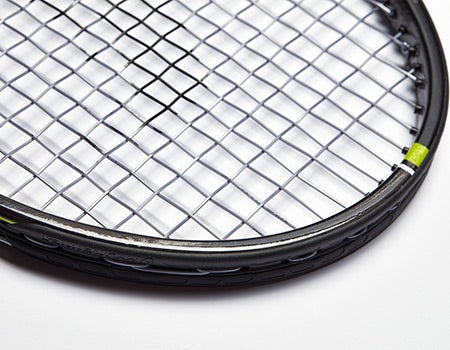
Returns - Score: 79
With an open string pattern, great dampening and lots of maneuverability, the Ki Q+ Tour Pro (315) let our testers get aggressive with their returns. Connecting big with her returns was Michelle, who said, "The 16x19 stringbed offered a good amount of spin along with great precision. I could swing out without overhitting or missing too often. The racquet felt stable as well, and I had no vibrations shooting up my arm if I didn't hit the ball just right."
Chris also liked the Ki Q+ Tour Pro (315)'s response on his returns. He said, "It felt livelier than the CX 200 Tour 16x19 I have also been testing. I was holding back a little at first, but as the test wore on I found I could trust the power level of the racquet more and more. Again, comfort was excellent. We used only stiff, poly-based strings in this racquet, and I had zero comfort issues."
Troy had a great time taking big swings on his return. He explained, "I felt like I could rip the ball without fear of it flying long. The precision of this racquet allowed me to pick my spots accurately on returns. My slice and chip returns worked well. They stayed low at my opponent's feet, especially when I sliced my backhand return. The stability was good when facing big servers, but a little more weight in the hoop wouldn't hurt in my opinion."
"My return is typically the Achilles heel of my game," admitted Mark, "and sadly I cannot report that the Ki Q+ Tour Pro (315) did much to help improve that. I think this also had a bit to do with the grip shape. I usually chip my return back into play, and I had the same issue with my backhand slice."
Overall - Score: 82
| Technical Specifications | ||
|---|---|---|
| Length | 27 in | 69 cm |
| Head Size | 98 sq in | 632 sq cm |
| Weight | 11.7 oz | 332 gm |
| Balance Point | 12.79 in 32 cm | 6pts Head Light |
| Construction | 19.5mm/19.5mm/19.5mm | |
| Composition | High Modulus Graphite/SpiralTech Carbon | |
| String Pattern | 16 Mains / 19 Crosses | |
| Babolat RDC Ratings | ||
|---|---|---|
| Score | Grade | |
| Flex Rating | 64 | Range: 0-100 |
| Swing Weight | 321 | Range: 200-400 |
| Chris' Scores | |||
|---|---|---|---|
| Power | 8.5 | Serves | 8.5 |
| Control | 8.3 | Groundstrokes | 8.3 |
| Maneuverability | 8.6 | Returns | 8.2 |
| Stability | 8.1 | Slice | 8.4 |
| Comfort | 9.5 | Topspin | 8.6 |
| Touch/Feel | 8.1 | Volleys | 8.3 |
| Overall | 8.5 | ||
| Troy's Scores | |||
|---|---|---|---|
| Power | 7.7 | Serves | 8.5 |
| Control | 8.9 | Groundstrokes | 8.5 |
| Maneuverability | 8.9 | Returns | 8 |
| Stability | 8.5 | Slice | 8.5 |
| Comfort | 9 | Topspin | 8.8 |
| Touch/Feel | 8.3 | Volleys | 8.2 |
| Overall | 8.4 | ||
| Mark's Scores | |||
|---|---|---|---|
| Power | 7.5 | Serves | 7.5 |
| Control | 8.5 | Groundstrokes | 7.5 |
| Maneuverability | 8 | Returns | 7.5 |
| Stability | 7.5 | Slice | 7 |
| Comfort | 8 | Topspin | 8 |
| Touch/Feel | 8 | Volleys | 8 |
| Overall | 7.5 | ||
| Michelle's Scores | |||
|---|---|---|---|
| Power | 7.8 | Serves | 8 |
| Control | 8 | Groundstrokes | 8 |
| Maneuverability | 8 | Returns | 8 |
| Stability | 8 | Slice | 8 |
| Comfort | 9 | Topspin | 8 |
| Touch/Feel | 8.5 | Volleys | 8 |
| Overall | 8.3 | ||
Playtester Profiles
Chris: 4.5 all-court player currently using the Tecnifibre TFlash 300 PS. Chris uses a full-western forehand grip, has a fast swing style and hits a one-handed backhand.
Troy: 5.0 lefty all-court player with a full Western Forehand and a two-handed backhand. Troy currently plays with a Yonex VCORE Pro 97 (330).
Mark: 5.0 lefty all-court player with a one-handed backhand. He currently plays with the Prince Phantom Pro 93P.
Michelle: Open level baseline player with a semi-western forehand and a two handed backhand. She currently plays with the Wilson Pro Staff RF 97 Autograph.
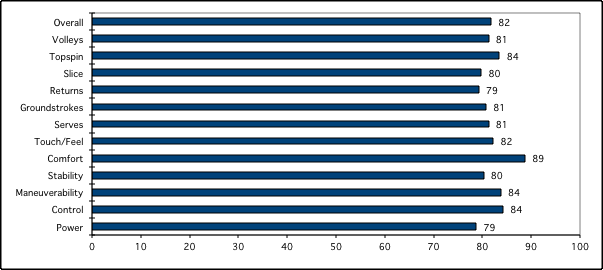




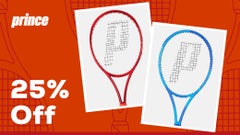
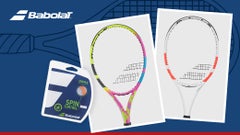
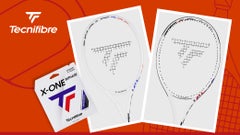

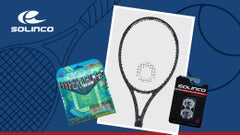
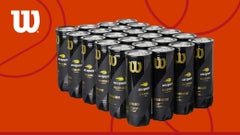
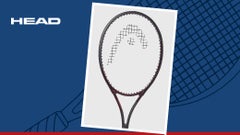
Likes
Chris - "I like the Ki Q+ Tour Pro (315)'s comfort, spin and blend of power and control. The specs are a great fit for me, and I feel very comfortable with it in my hands."
Troy - "It was a very easy transition from my current racquet of choice, the Yonex VCORE Pro 97 (330). Control is at a high level, and the spin comes with ease. The Kinetic System technology makes for a very plush, comfortable feel on contact."
Mark - "I feel the ProKennex Ki Q+ Tour Pro (315) is a high-quality addition to the traditional frame choice menu. I also really liked the updated cosmetic of all the new ProKennex frames, listing their number race-car style on the throat of the frame."
Michelle - "This racquet is comfortable, with a great blend of power and control."
Dislikes
Chris - "None."
Troy - "If you aren't familiar with ProKennex racquets, the Ki Q + Tour Pro (315)'s feel can be somewhat muted. A leather grip would be a nice addition to bring up the weight and increase the feel."
Mark - "To my hand, the grip shape of the new Ki Q + Tour Pro (315) is similar to a Volkl pallet or the Head Prestige pallet. It is not a game changer for my game, but the two main bevels are quite broad, and I sort of prefer the more quadratic shape of Wilson, Dunlop or Prince grip pallets."
Michelle - "Nothing to report. This racquet just does everything well for me. I can say I had zero complaints during the playtest. If anything, I might want to try it with a little more weight (maybe I should try the 325g version, but that one has an 18x20 string pattern)."
Comparing the racquet to others they've tried, our testers said:
Chris - "I would compare the Ki Q + Tour Pro (315) to the Dunlop Srixon CX 200 Tour 16x19, the Tecnifibre TFight 315 XTC Ltd and the Volkl V-Sense 10 Tour. This Ki Q + Tour Pro (315) offers a slightly livelier response off the stringbed. It also plays a bit more muted due to the Kinetic system, whereas the others offer a more traditional response."
Troy - "The Ki Q + Tour Pro (315) is a nice addition to the Tour line of ProKennex racquets. I thought that the previous version of the Ki Q+ Tour Pro (325) would have played well with a 16x19 string pattern. This Tour Pro (315) offers what I was looking for, and it gives me the option of adding a leather grip without making the racquet too heavy. Other racquets that compare are the Dunlop Srixon CX 200 Tour 16x19, Head Graphene Touch Prestige Pro, Prince Textreme Tour 95, Yonex VCORE Pro 97 (310), Babolat Pure Strike VS Tour and Tecnifibre TFight 315 Ltd. XTC (16x19)."
Mark - "I grew up with lots of ProKennex tennis racquets, like the Boron/Copper/Black Aces, and I still have an older Graphite Micro OS with a 24x27 string pattern. The Ki Q+ Tour Pro (315) actually reminds me of a Black Ace 98, but with a 16x19 string pattern. Between Seppi's model, which weighs a bit over 12 ounces and is paired with an 18x20 pattern, and the 300-gram version of the Ki Q Tour being too light for me, this new 315-gram addition to the ProKennex frame lineup qualifies as the Goldilocks of the bunch. Other comparable frames are the Head Touch Prestige Pro, Dunlop Srixon CX 200 Tour 16x19, Yonex VCORE 97 (310) and Tecnifibre ATP TFight 315 XTC."
Michelle - "The Ki Q + Tour Pro (315) reminded me of a lighter version of my racquet (the Wilson Pro Staff RF97 Autograph) or the standard Pro Staff 97, though I noticed that the thinner beam of this ProKennex gives it a bit more feel and is possibly a bit more flexible as well."